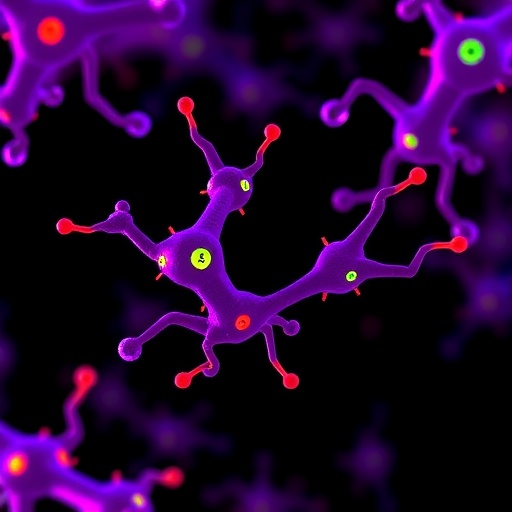In recent years, the persistent challenge posed by biofilms has sparked considerable research interest, particularly in their relationship with pathogenic bacteria such as Staphylococcus aureus. This bacterium is notorious for its ability to form biofilms, which are structured communities of bacterial cells encased in a self-produced polymeric matrix. This capacity not only enhances its survival in hostile environments but also contributes to its virulence, making infections difficult to treat. The emergence of antibiotic-resistant strains has further complicated the therapeutic landscape, necessitating innovative approaches to eliminate biofilm-related infections.
A groundbreaking study led by Khongrin et al. presents a novel strategy to combat biofilms using phages displayed with domain antibodies. This innovative approach represents a significant leap in the field of targeted therapy, where specificity and efficiency are paramount. The researchers have harnessed the unique properties of bacteriophages—viruses that infect bacteria—to construct phages that carry antibodies specifically designed to target Staphylococcus aureus biofilms. This dual mechanism not only enhances the ability to locate and attach to the biofilm but also facilitates the subsequent destruction of the pathogens within.
The researchers emphasize that traditional antibiotics often fail against biofilms due to the protective matrix they produce. This matrix acts as a physical barrier, preventing drugs from penetrating, thus rendering many treatments ineffective. By utilizing phages that are adorned with domain antibodies, this study opens new pathways to potentially penetrate and disrupt this protective barrier effectively. Such biofilm-targeted therapy could represent a paradigm shift in treating infections that conventional methods struggle to manage.
.adsslot_idFyMm0XB7{width:728px !important;height:90px !important;}
@media(max-width:1199px){ .adsslot_idFyMm0XB7{width:468px !important;height:60px !important;}
}
@media(max-width:767px){ .adsslot_idFyMm0XB7{width:320px !important;height:50px !important;}
}
ADVERTISEMENT
Phages have been renowned in bacteriology for their specificity and ability to replicate rapidly in the presence of their bacterial hosts. However, their full potential in biofilm eradication has not been adequately explored until now. Khongrin and colleagues have meticulously crafted phages that not only locate biofilms but are also armed with antibodies to initiate bacterial lysis. This specificity minimizes collateral damage to beneficial microbiota, presenting an advantage over broad-spectrum antibiotics and allowing for a more tailored approach to treatment.
The novelty of this research lies in its integrative methodology. By combining the robust biocontrol mechanisms of phages with the precision of domain antibodies, the team has developed a platform that could set the groundwork for future advances in microbial therapies. Their findings show that the modified phages can significantly reduce biofilm density in laboratory settings, suggesting that this approach holds substantial promise for clinical applications.
Moreover, the study sheds light on the fundamental mechanisms of biofilm formation and dispersal. The data indicate that the antibody-displayed phages can induce biofilm disruption, leading to enhanced bacterial susceptibility to subsequent therapeutic agents. This synergistic effect could be a game-changer in managing chronic infections where biofilm-associated pathogens resist standard treatments.
Another intriguing aspect of this research is the potential to develop customized therapies that pair specific phages with antibodies aimed at various bacterial pathogens. As antibiotic resistance continues to rise, personalized medicine could play a crucial role in addressing infection vulnerabilities. Tailoring therapy to the specific biofilm profiles of patients may lead to enhanced efficacy and improved patient outcomes.
Safety and effectiveness are vital considerations in any novel therapeutic approach. The research demonstrates that the phages used in their studies were non-toxic, raising the potential for this treatment method to be integrated into existing clinical paradigms without significant concern for adverse effects. With careful regulation and further clinical trials, there is hope that this therapy could soon transition from laboratory to bedside.
Furthermore, the implications of this research extend beyond just Staphylococcus aureus. The methodology outlined could potentially be adapted to address biofilms associated with other critical pathogens. This versatility may pave the way for comprehensive solutions to a broader range of infectious diseases. The challenges posed by biofilms present a pressing need for innovative techniques, and this study marks a significant milestone toward achieving that goal.
In summary, the work of Khongrin et al. underscores the potential for phage therapy combined with domain antibody technology to provide effective solutions against biofilm-associated infections. As research continues to unveil the complexities of microbial communities, strategies such as these may emerge as crucial tools in the ongoing battle against stubborn infections. The scientific community will undoubtedly be watching closely as these findings progress toward potential clinical applications.
As we face the mounting crisis of antibiotic resistance, the need for innovative strategies to combat infections has never been more urgent. The promising results from this study not only inspire further investigation but also raise hope for future therapeutic options that harness the power of biotechnological advancements. The convergence of phage and antibody technology may well signal a new era in infection control, potentially leading to effective treatments that save lives and reduce the burden of infectious diseases globally.
In conclusion, the work of Khongrin and colleagues serves as a reminder of the importance of innovation in microbial therapy. As researchers continue to explore the possibilities of phage engineering and antibody design, we may soon witness the evolution of treatment strategies that revolutionize the management of infectious diseases. The integration of these scientific advances not only suggests a shift in how we approach treatment but may also foster a renaissance in tailored therapies equipped to handle the complexities of biofilm-associated pathogens.
Subject of Research: Biofilm-targeted therapy using phage-displayed domain antibodies for Staphylococcus aureus.
Article Title: Domain antibody–displayed phages as a novel biofilm-targeted therapy for Staphylococcus aureus.
Article References: Khongrin, K., Aiamsung, M., Rasri, N. et al. Domain antibody–displayed phages as a novel biofilm-targeted therapy for Staphylococcus aureus. Int Microbiol (2025). https://doi.org/10.1007/s10123-025-00698-9
Image Credits: AI Generated
DOI: https://doi.org/10.1007/s10123-025-00698-9
Keywords: Biofilm, Staphylococcus aureus, phage therapy, domain antibodies, antibiotic resistance, microbial therapy.
Tags: antibiotic-resistant bacteriabacterial cell communitiesbacteriophage technologybiofilm eradication strategiescombating biofilmsnovel therapeutic approachespathogenic biofilm challengesphage therapy advancementsphage-displayed antibodiespolymeric matrix in biofilmsStaphylococcus aureus infectionstargeted therapy innovations





